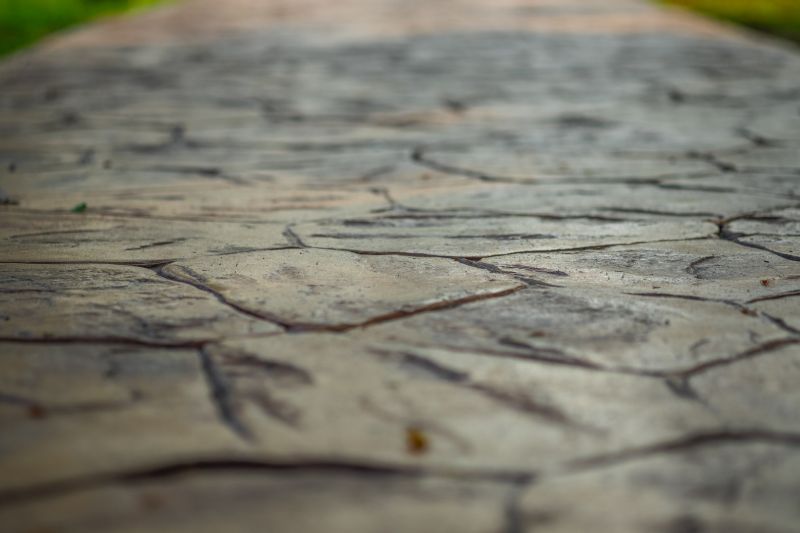Top Tools For Enhancing Stamped Concrete Service Results
Upgrade your stamped concrete projects with high-performance tools that ensure consistency and quality outcomes.
 Stamped concrete service is a popular choice for enhancing the aesthetic appeal of outdoor surfaces such as patios, driveways, and walkways. This decorative technique involves imprinting patterns and textures onto freshly poured concrete, creating the appearance of materials like brick, stone, slate, or tile. To achieve durable and visually appealing stamped concrete, a variety of specialized products are used throughout the process, from surface preparation to finishing touches.
Stamped concrete service is a popular choice for enhancing the aesthetic appeal of outdoor surfaces such as patios, driveways, and walkways. This decorative technique involves imprinting patterns and textures onto freshly poured concrete, creating the appearance of materials like brick, stone, slate, or tile. To achieve durable and visually appealing stamped concrete, a variety of specialized products are used throughout the process, from surface preparation to finishing touches.
Top Overall Option
High-Quality Concrete Stamping Kit
A comprehensive stamping kit that includes a variety of texture mats, release agents, and sealers designed to work together for consistent, professional results. Ideal for both contractors and serious DIYers, this kit offers versatility and durability to help achieve realistic stone or brick patterns on stamped concrete surfaces.
Types of Products For Stamped Concrete Service
Concrete Stamp Mats
Flexible mats with various patterns used to imprint textures onto wet concrete, creating realistic stone, brick, or tile appearances.
Release Agents
Powders or liquids applied to molds or concrete surfaces to prevent sticking and ensure clean pattern transfer.
Color Hardener
Powdered coloring agents sprinkled onto concrete to add color and enhance the stamped pattern's visual depth.
Integral Color
Color pigments mixed directly into the concrete mix for uniform coloration throughout the slab.
Liquid Color Stains
Transparent liquid dyes applied after stamping to add accents and enhance the pattern's appearance.
Sealers
Protective coatings that seal the stamped surface, providing gloss, UV resistance, and protection against stains and wear.
Acid Stains
Chemical stains that produce variegated color effects, adding depth and character to stamped concrete.
Texturing Brushes and Rollers
Tools used to add additional textures or refine patterns on stamped concrete surfaces.
Overlay Products
Resilient overlays that can be stamped or textured to restore or enhance existing concrete surfaces.
Jointing Tools
Tools designed to create control joints for cracking control and aesthetic separation in stamped concrete.
Concrete Admixtures
Additives that improve workability, setting time, or durability of stamped concrete mixes.
Curing Compounds
Products that retain moisture in the concrete to promote proper curing and reduce cracking.
Edge Restraints
Materials used to define borders and contain stamped concrete, ensuring clean edges.
Popular Choices
A variety of patterned mats used to create textured surfaces resembling natural stone or brick.
Sealers with enhanced durability and gloss, suitable for outdoor stamped concrete surfaces.
Vibrant pigments that can be mixed into concrete or applied as stains for decorative effects.
Fine powders used to facilitate pattern release and prevent sticking during stamping.
Thin layers of textured material applied over existing concrete to add decorative patterns.
Sealants designed to withstand sunlight exposure without fading or peeling.
Stains that produce variegated colors, adding visual interest to stamped surfaces.
Tools used to add additional surface textures or accents after stamping.
Tools to create control joints that help manage cracking and define design patterns.
Materials used to cover freshly poured concrete for optimal curing conditions.
Materials to create clean, defined edges for stamped concrete slabs.
The success of a stamped concrete project depends heavily on the quality and suitability of the products employed. Proper sealers, coloring agents, release agents, and stamping tools are essential components that influence the final look and longevity of the surface. Professionals in Post Falls, ID, often select products that are easy to work with, provide consistent results, and withstand the outdoor elements over time.
When selecting products for stamped concrete, it is important to consider the specific pattern, texture, and color effects desired. Different products offer unique features, such as enhanced slip resistance, UV stability, or ease of application. High-quality products can help ensure that the decorative surface maintains its beauty and structural integrity for years to come, making them a worthwhile investment for contractors and DIY enthusiasts alike.
Ultimately, choosing the right products for stamped concrete involves balancing aesthetic goals with practical considerations like application environment and maintenance. Consulting with local suppliers or experienced professionals in Post Falls can provide valuable insights into the most suitable options for your project. Proper product selection not only enhances the visual appeal but also contributes to the durability and safety of the finished surface.
Key Buying Considerations
- Compatibility of products with existing or planned concrete surfaces.
- Ease of application, especially for DIY projects versus professional use.
- Durability and weather resistance of sealers and colorants in outdoor environments.
- Compatibility of release agents with stamping mats to ensure clean pattern transfer.
- Color options and whether they can be customized to match design preferences.
- Slip resistance properties, especially for surfaces in high-traffic or wet areas.
- UV stability of color and sealant products to prevent fading over time.
- Ease of cleaning and maintenance of stamped concrete surfaces.
- Environmental conditions during application, such as temperature and humidity.
- Availability of comprehensive kits versus individual products for flexibility.
- Compatibility of overlays and repair products with existing concrete surfaces.
- Cost considerations balanced with product quality and expected longevity.
- Manufacturer reputation and reviews for consistent product performance.
- Availability of technical support or guidance from suppliers.
- Safety measures during application, including proper ventilation and protective gear.
This page contains affiliate links. We may earn a commission if you purchase through these links, which helps support our content and services.
